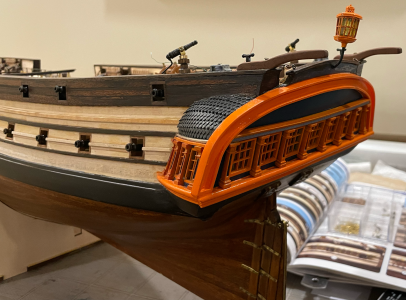There is never too much information,

but if I have the contemporary drawings and a contract, and follow them, I know that no one can say something is the wrong size. Contemporary models are often a big help as well. Drawings in the AOTS books are supposedly based on the contemporary same information, so I see no reason to use them if I can get the original information at no cost and not worry about the mistakes in the AOTS books. I bought six of the AOTS books for about $5 when NRG sold off its library and have consulted them as many of the drawings are really good, but they need to be checked as they are not always correct. Example, in the AOTS
Diana book the drawings of the long guns look very much like Borgard pattern guns which went out of use 70 years before
Diana was launched.
Rigging,,,,,,, always a difficult part of a build regarding finding information. IMHO sails at our common scales don't look good so I try to leave them off. Sewn sails usually look terrible as there is no cloth that is to scale at 1:48 or smaller. Even at 1:24 it is a stretch. If a client insists on sails I usually go with silk span but if cloth is mandated, and the scale is 1:48 or larger I find the highest thread count Egyptian cotton material that I can. For rigging before 1720 Lees'
The Masting and Rigging of English Ships of War. and Anderson's
The Rigging of Ships in the Days of the Spritsail Topmast are favorites for many folks. I would prefer contemporary drawings but there are not very many available and none give information on belaying points or rope sizes, at least that I have been able to find so far. For the period from 1720 onward I rely mainly on Lees' book but for circa 1800 I compare it to information from Steel's
The Elements and Practice of Rigging and Seamanship. The drawings from Petersson in
Rigging Period Ship Models are helpful but as the book is based on a single contemporary model of a fifth rate from 1785, it is limited. Biddlecome's
The Art of Rigging is another book with very useful information.
I really hope there were contemporary sources on rigging in addition to the few drawings and the stores lists and someone finds and publishes them.
Allan










